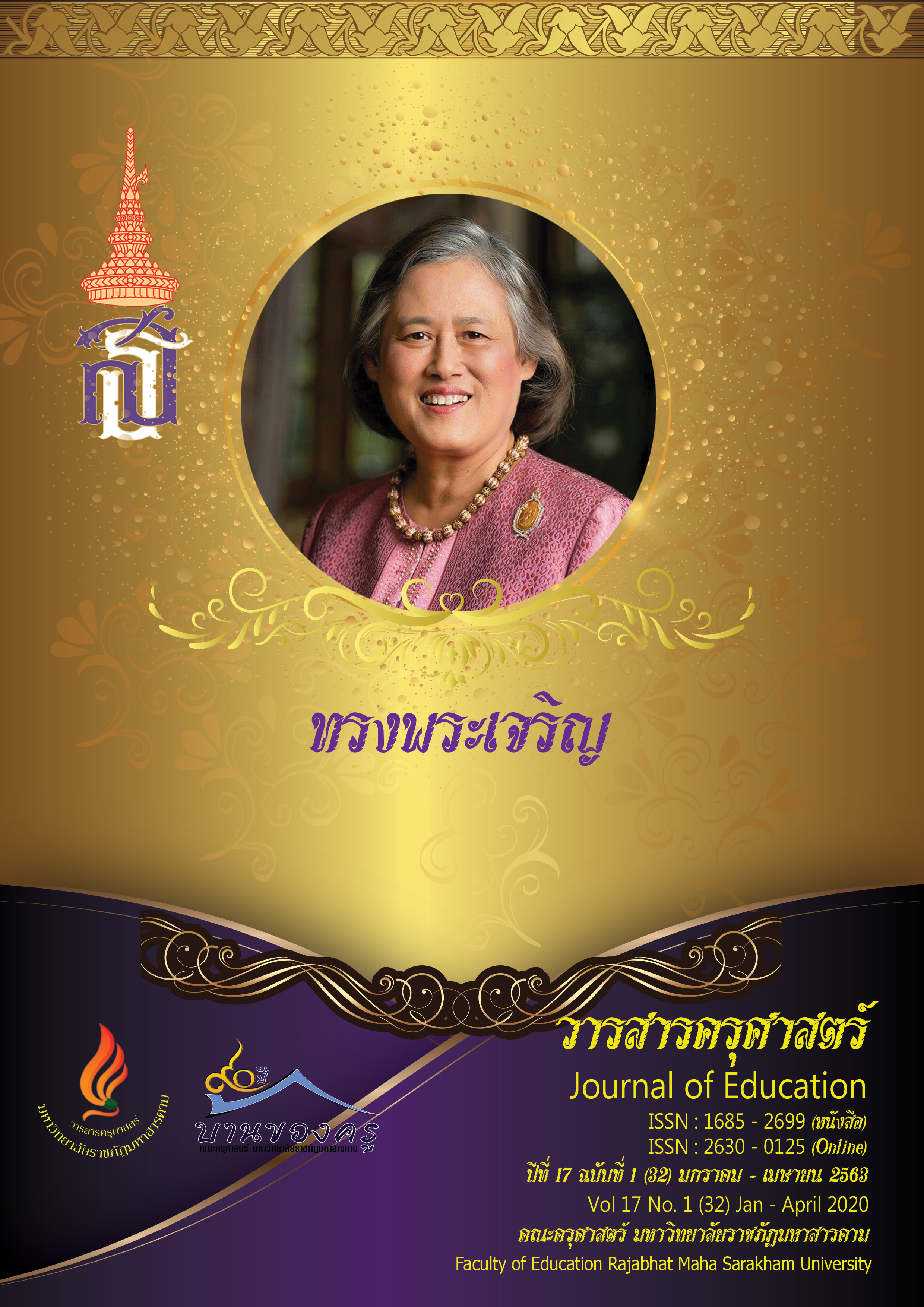Brand Image Analysis of Football Fanclub Attitude TowardsbProfessional Football Team in Thailand
Main Article Content
Abstract
The research aims were to determine following objectives 1) study a factor that impacts
the football team’s image in Thai league 2) compare factors that impacts the football team’s
image in Thai league. This study used quantitative research by using questionnaire for interview Thai
football team fan club 2017-2018 focusing only Thai league team 1 which had 18 teams and total
sample size was 450. Tooling for research is questionnaire. Analysis methodology were analysing
content and descriptive statistic such as percentage, mean, standard deviation, inferential statistic
and comparing different groups by using t-test and F-test.
The research results were follows: 1. Profile of Thai football fan club in Thai League, mostly
male at 60.2% and average age 15-25 years old at 46.2%, had bachelor degree as their high
education level at 44%, mostly was business owner at 30.9% and average income was
10,001– 20,000 Baht per month 2. Attitude of Thai football fan club towards Thai football team’s
image by using F-test and filter by occupation was difference at 95% significant level in all factors
and 3. Attitude of Thai football fan club towards Thai football team’s image by using F-test and
filter by income was difference at 95% significant level in almost factors, except credibility.
Article Details
ข้อกำหนดเบื้องต้นที่ผู้นิพนธ์(ผู้ส่งบทความ) ควรทราบ
1. ผู้นิพนธ์ที่ประสงค์จะลงตีพิมพ์บทความกับวารสาร ตั้งแต่เดือนมกราคม 2563 เป็นต้นไป ให้ใช้รูปแบบใหม่ (Template 2563) โดยสามารถดูตัวอย่างได้ที่เมนู GUIDELINES
2. จะตีพิมพ์และเผยแพร่ได้ ต้องผ่านการประเมินจากผู้ทรงคุณวุฒิ (Peer Review)
3. การประเมินบทความโดยผู้ทรงคุณวุฒิ (Peer Review) เป็นแบบ Double Blind
4. การอ้างอิงบทความใช้หลักเกณฑ์ APA (American Psychological Association) คลิก
5. บทความถูกปฏิเสธการตีพิมพ์ ไม่ผ่านการประเมิน ผู้นิพนธ์ขอยกเลิกเองหรือชำระเงินก่อนได้รับการอนุมัติ ทางวารสารไม่มีนโยบายการคืนเงิน
References
มูลค่าหลักพันล้าน. ไทยรัฐออนไลน์. สืบค้นจาก http://www.thairath.co.th/content/608875
ศูนย์วิจัยกสิกรไทย. (2559, 10 ตุลาคม). ความนิยมในกีฬาฟุตบอลของไทย สร้างเม็ดเงินหมุนเวียนกว่า 12,000
ล้านบาท. ฐานเศรษฐกิจ. สืบค้นจาก http://www.thansettakij.com/content/81358
สมหวัง พิธิยานุวัฒน์. (2541). วิธีวิทยาการประเมินทางการศึกษา. กรุงเทพมหานคร: จุฬาลงกรณ์มหาวิทยาลัย.
Aaker, D. (2009). Building innovative brand: Standford graduate school of business. New York:Morgan James Publishing.
ATkearney. (2014). Winning in the business of sports. A.T. Kearney. Inc.
Jeerawat, N. T. (2015, 10 August). Aleague of their own: Once considered a joke, professional Thai football is more popular and profitable than ever, and top clubs and sponsors are cashing in. Bangkok Post. Retrieved from https://www.bangkokpost.com/thailand/specialreports/656856/a-league-of-their-own
Darren, H. (2015, 19 October). Sports industry to reach $73.5 billion by 2019. Retrieved from http://www.forbes.com/sites/darrenheitner/2015/10/19/sport-industry-to-reach-73-5-billion-by-2019
Ghodeswar, B. M. (2008). Building brand identity in competitive markets: a conceptual model.Journal of Product & Brand Management, 17(1), 4–12.
Gladden, J. M., and Funk, D. C. (2002). Developing and understanding of brand associations in team sport: Empirical evidence from customer of professional sport. Journal of Sport Management, 16(1), 54-81.
Invest Northern Ireland. (2012). Guide to opportunities for supply to international sporting events. Belfast: UKTI and Invest NI.
Keller, K. L. (2013). Strategic brand management: Building, measuring, and managing brand equtiy [4th ed]. Essex: Pearson Education, Inc.
Koo, J. J. (2009). Brand management strategy for Korean professional football teams : A model for understanding the relationships between team brand identity, fans’ identification with football teams, and team brand loyalty. (Doctoral Dissertation, Brunel University). Retrieved from https://core.ac.uk/download/pdf/40049463.pdf
Kotler, P., and Foertsch, W. (2006). B2B brand management. With the corporation of Ines Michi:Berlin, Springer.
Mahawaleerat, S., and U-On, V. (2015). The management of professional sports media in Thailand:
Case study of Thai premier league company limited. Panyapiwat Journal, 7(1), 76-85.
Manchester United plc. (2014). Annual report pursuant to section 13 or 15(d) of the securities exchange act of 1934: For the fiscal year ended 30 June 2014. United States Securities and Exchange Commission: Washington, D.C.
Morgan, R. M., and Hunt, S. D. (1994). The commitment-trust theory of relationship marketing.Journal of Marketing, 58(3), 20-38.
Nimakorn, C., Samahito, S., and Kutintara, I. (2013). A business model development for a professional women’s volleyball league in Thailand. ABAC Journal, 33(1), 38-56.
Pookaiyaudom, G. (2014). The emergence of sport event tourism destination in Buriram. Journal of Faculty of Sports Science, Chulalongkorn University, 15(3). 1-8.
Saito, S. (2011, 25-26 May). How marketing mobilize professional sports. KU Sport Management Summit 2011, Kasetsart University, Bangkok.
Shank, M. D. (2002). Sports marketing: A strategic perspective [2nd ed]. New Jersey: Pearson Education, Inc.
Stotlar, D. K. (2016). Asia rising: The growth and potential of Asia sport. KU-SS Sports Management International Conference 2016. (pp. 28-36). Bangkok, Thailand.
Tsiotsou, R. (2012). Developing a scale for measuring the personality of sport teams.Journal of Services Marketing, 26(4), 238-252.
Wood, L. (2000). Brands and brand equity: definition and management. Sheffield Hallam University: Sheffield, UK.
Zhang, Y. (2015). The Impact of brand image on consumer behavior: A literature review. Open Journal of Business and Management, 3(1), 58-60.


